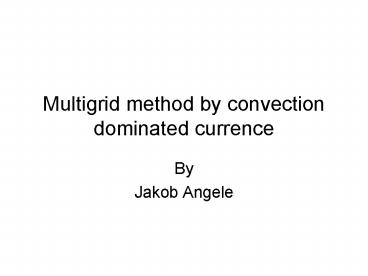Multigrid method by convection dominated currence - PowerPoint PPT Presentation
1 / 25
Title:
Multigrid method by convection dominated currence
Description:
Diagonally dominant. Basic Iterative Methods. Jakobi Method. Model problem. First iteration ... The order of updating is significant. Ascending and descending order ... – PowerPoint PPT presentation
Number of Views:110
Avg rating:3.0/5.0
Title: Multigrid method by convection dominated currence
1
Multigrid method by convection dominated currence
- By
- Jakob Angele
2
Model Problem
- Aproximation with
- finite difference method
- n subintervalls length h1/n
- n-1 linear equations
- Properties of A
- Symmetric
- Block tridiagonal
- Spare
- Diagonally dominant
3
Basic Iterative MethodsJakobi Method
- Model problem
- First iteration
- Splitting matrix A
- In matrix-form
- 2n storage locations are needed
4
Gaus-Seidel Method
- Components of a approximation are used as soon as
they are computed. n storage locations. - In matrix-form
- The order of updating is significant
- Ascending and descending order
- Red-black Gause-Seidel method
5
Weighted Jakobi Method
- Weighted Jakobi iteration
- Eigenvalues
- Eigenvectors
- Wave numbers greater then n cannot be represented
correctly on the grid
6
Decreasing of the Error
- Eigenvectors
7
Calculation of Eigenvalues
- Weighted Jakobi iteration
- Eigenvalues of
- with
- The eigenvectors of A are the same as the
eigenvectors of
8
Calculation of Eingenvalues
- Eigenvalueproblem
- The j-th line
- This equals
- By using the identity
- one can get
- Finally by using
- one can get
9
The Error
- Each method discussed so far may be present in
the form - All iterative method are designed so that the
following equation is true - Error done by approximation
- Furthermore, the error can be written as
- This leads to an Error after m iterations
10
The Error
- Significance of the weighting factor
11
The Error
- If the eigenvalue is small, the error decreasing
effectively with each iteration. - If the eignevalue is close or equal to 1 the
error does not decrease significantly. - We choose . All the eigenvalues
with an are smaller then . - These components of the error are dumped
effectively. - They correspond to the oscillatory eigenvectors.
12
The Error
- Smooth modes with are eliminated slowly.
- Oscillatory modes with are eliminated
quickly.
13
Convergence of different modes
- Convergence slows down and eventually seems to
stall.
14
Convergence of different modes
- Efficient elimination of the oscillatory modes
- It cannot eliminate the oscillatory modes
effectively!
15
The Multigrid
- For the approximation different grids are used.
- Coarser grids are introduced. Each new grid has
half as many grid points as the previous one. - Different components of the error are can be
approximated effectively on different grids. - The values calculated on one grid can be
interpolated from one to another grid and so
enhance the values there.
16
Multigrids
- What does smooth wave look like under a coarser
grid? - Grid transformation
- Grid points of the grid are the even numbered
grid points of the old one - The eigenvectors are transformed
- A smooth mode appears on a coarser grid as a more
oscillatory one. - There, it can be approximated effectively with
same iteration method.
17
Multigrids
- A wave with wavenumber k6 on Oh (n12 points is
projected ont O2h (n6 points) - The coarser grid sees the wave as more
oscillatory on the grid then on the fine grid
18
Linear Interpolation
- The easiest method to transfer values from a
courser grid to a finer grid is through linear
interpolation. - This method is most of the time sufficient
enough. - For the case on n8 the linear interpolation
operator has the following form
19
Linear Interpolation
- How well does linear interpolation work?
- The exakt error is smooth. When the coarsegrid
approximation is interpolated to the fine grid,
the interpolation is also smooth. - Therefore the linear approximation is very
accurate. - (b) The exakt error is oscillatory. But the
interpolation to the fine grid is still smooth.
Therefore the approximation is not very
effective.
20
Linear Interpolation
- Linear interpolation works best on smooth errors.
- Relaxation methods, like Gause-Seidel, work best
on osscillatory error. - Algorithm
- Error is made smooth by a relaxation mehtod.
- Smooth error is interpolated to a coarser grid.
- The error appears more oscillatory.
- The error made smooth again through relaxation.
21
Intergrid Transfer
- The second class of linear transfer is moving
from a fine grid to a coarse grid - These operators are called restriction operators.
- Two important restriction operators
- Injection
- Full weighting
22
Injection
- Injection takes its values directly from the fine
grid. - It is definded simply by
- For the case n8 the injection operator has the
form
23
Full weighting
- Full weighting is defined by
- Again, on a grid with n8 the full weighting
operator is represented by - An important property of the full weighting
operator - It is the transposing of the linear interpolation
operator.
24
Multigrid Problems with k-d equations
- The smoothing through Gause-Seidel or other
approximation becomes inefficient. - If the order of relaxation is not in direction of
the current the approximation substantional
improves only to the next grid point. - The numbering of the grid points has to be
adjusted to the current. - Stability of coarser grid
- Due to the strong current, the second coarser
grid is loosing its symmetric dominant property - The Gause-Seidel method is a lot more inefficient
- Errors occur through interpolation of the
solutions from one grid to another - Main Problem The coarser grids have to be chosen
so that - Diffusion may not be overrepresented.
25
Ideal Coarse Grid
- Ordinary gird Through approximation the
diffusion is overrepresented - The ideal grid approximates the current a lot
more precise































